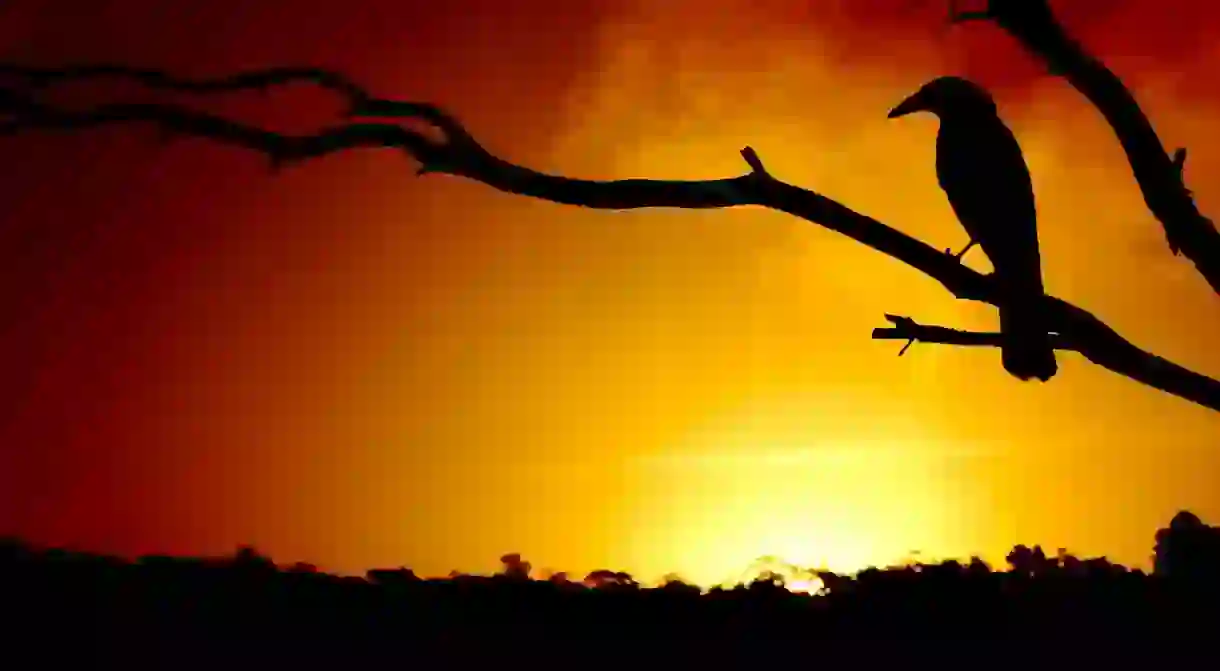11 Fascinating Indigenous Australian Myths and Legends

The Dreaming — in essence, the worldview of Indigenous Australian culture — contains dozens of stories that explain the creation process of the world around us. Here are 11 of the most fascinating myths and legends told by Australia’s First Peoples.
The Rainbow Serpent
This legend is the quintessential Dreaming story, and easily the most widely known around Australia. There are countless regional variations sculpted by the hundreds of difficult Indigenous cultures and language groups, but the common thread is that a huge snake slumbers beneath the Earth’s surface until it emerges from the ground to awaken different groups of animals and to travel through the landscape forging hills, lakes, valleys and rivers in previously featureless terrain.

The Three Brothers
Where New South Wales meets Queensland and South Australia in the barren outback, there were three brothers who were leaders of their Wangkumara tribe … until they were tempted to swim across the river and fraternise with women from another group. Their punishment? Immolation, which transformed the siblings into three upright rocks. Only one of the brothers remains standing today.
The Emu and the Jabiru
Arnhem Land in the Northern Territory is fertile soil for Dreaming stories, including this one about a feisty family feud. After hunting some stingray, Gandji and his kids returned to camp to share the meat with Wurrpan and his family. However, Gandji stashed all the tastiest bits for himself, and Wurrpan wasn’t overly happy about that. When the two began to fight with spears and hot coals and rocks, Gandji flew away and turned into a jabiru (stork) and Wurrpan transformed into an emu.

Why the Crocodile Rolls
On the north coast of Western Australia, there was a very unhappy young woman named Min-na-wee, who would always start trouble among her tribe. One day in a massive fight, a man grabbed Min-na-wee and rolled her around in the dirt to restrain her. Intent on revenge, she transformed into a crocodile and waited in the water to give that bloke a taste of his own medicine, and that’s why crocs continue to roll their prey today.
Black Mountain
Kalkajaka — or ‘place of spear’ in English — is a mass of black granite boulders in tropical North Queensland that includes four sites of religious significance for the Kuku Nyungkal people: Kambi (a cave where flying foxes are found), Julbanu (a rock shaped like a kangaroo), Birmba (a stone cockatoos call home), and the taboo place of Yirrmbal. The legend of Black Mountain assumed extra significance upon European arrival, when colonists and their horses and cattle would regularly disappear into gaping crevasses between the boulders.

How the Water Got to the Plains
The Butchulla people of Fraser Island tell the story of how a pair of greedy men — Weeri and Walawidbit — stole some precious water from the arid desert then chased across the countryside by warriors. Little did they know, their tanks were leaking, spilling water all over the landscape to form life-giving rivers, billabongs and watering holes.
Devil’s Pool
Babinda Boulders near Cairns took on this spooky name thanks to a runaway bride named Oolana who leapt to her watery grave when she was separated from her would-be husband. Indigenous legend has it that she’s been luring men into the dangerous swimming hole ever since. Devil’s Pool has claimed 17 lives since 1959, and it’s now fenced off with the eerie epitaph ‘He came for a visit … and stayed forever’.

Uluru
The Rock carries serious spiritual significance to the local Anangu people, and cultural ceremonies have taken place at the rock for more than 10,000 years. But this legend concerns visitors, not the traditional landowners. The Anangu have reported that they’re inundated with packages loaded with rocks that tourists have pilfered from Uluru then sent back to their rightful home, because the souvenirs have supposedly cursed their lives.
The Eaglehawk and the Crow
This Ngiyaampaa story from western New South Wales begins with the eaglehawk asking his neighbour the crow to mind his baby while he went hunting, but the crow didn’t have an especially good temperament for babysitting — he bludgeoned the child to death when it wouldn’t stop crying. Seeking revenge upon return, the eaglehawk chased the crow into the bush then set it alight to try and kill him; the crow managed to fly away, but not before it had been charred black.

The First Fire
This tale from the North Coast of New South Wales describes a tribe of people who lived in the sky world, and could light fires using nearby stars before anyone on Earth could spark a flame. A couple of adventurous sky world people popped down to Earth to hunt possums with their fire sticks, creating a huge blaze that various tribes could use to take fire back to their own camps.













